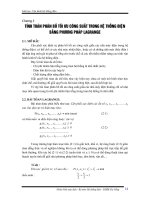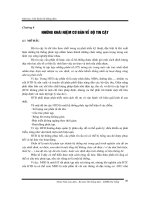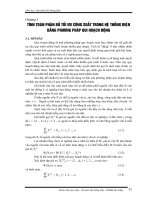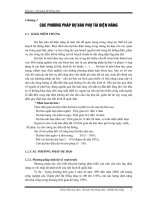TỐI ƯU HÓA VẬN HÀNH HỆ THỐNG ĐIỆN
Bạn đang xem bản rút gọn của tài liệu. Xem và tải ngay bản đầy đủ của tài liệu tại đây (19.97 MB, 271 trang )
2/16/2014
TỐI ƯU HÓA VẬN HÀNH
HỆ THỐNG ĐIỆN
Chapter 1:
CONCEPT AND DEFINITION
by
Dr.Vo Ngoc Dieu
Department of Power Systems
HCMC University of Technology
Email:
Introduction
•
•
•
•
•
•
•
In 1831, Michael Faraday’s many years of efforts rewarded when he
discovered electromagnetic induction
Later, he invented the first generator
Today, electric energy technologies have a central role in social and
economic development at all scales
Energy is closely linked to environmental pollution and degradation, to
economic development and quality of life
Today, we are mostly dependent on nonrenewable fossil fuels that have
been and will continue to be a major cause of pollution and climate
change
Finding sustainable alternatives is becoming increasingly urgent
Operation and control of power system is an extremely complex task
2
1
2/16/2014
Definitions
•
•
•
•
Electric Capacity is a term that defines the rated continuous loadcarrying ability, expressed in megawatts (MW) or megavolt-amperes
(MVA) of generation, transmission, or other electrical equipment
Electric Energy is the term that defines the generation or use of
electric power by a device over a period of time. It is expressed in
kilowatt-hours (kWh), megawatt-hours (MWh), or gigawatt-hours
(GWh)
In context of electric circuits, the term ‘load’ refers to any device in
which power is being dissipated (i.e. consumed)
In larger context of the power system, loads are usually modeled in an
aggregated way rather than an individual appliance. Load may refer to
an entire household, a city block or all the customers within a certain
region
3
Type of loads
• Resistive loads (25%):
Heating and lighting equipments
e.g.Toaster, iron, electric blankets, Incandescent
lamps
• Motors (70%):
Compressors (air conditioner, refrigerator)
Pumps (well, pool), Fans
Household appliances (washer, mixer, vacuum
cleaner)
Large commercial 3-phase motors (grocery store
chiller)
Power tools (hand drill, lawn mower)
Electric street cars
Basically ‘anything’ that moves!
• Electronic devices (5%): Power supplies for computers etc.
Transformers (adapter, battery charger)
4
2
2/16/2014
Type of loads
•
From system’s point of view, there are 5 broad category of loads: Domestic,
Commercial, Industrial, Agriculture and others
Domestic:
lights, fans, domestic appliances like heaters, refrigerators, air conditioners, mixers,
ovens, small motors etc.
Demand factor = 0.7 to 1.0; Diversity factor = 1.2 to 1.3; Load factor = 0.1 to 0.15
Commercial:
Lightings for shops, advertising hoardings, fans, AC etc.
Demand factor = 0.9 to 1.0; Diversity factor = 1.1 to 1.2; Load factor = 0.25 to 0.3
Industrial:
Small scale industries: 0-20kW
Medium scale industries: 20-100kW
Large scale industries: above 100kW
5
Type of loads ……Cont’d
Industrial loads need power over a longer period which remains fairly
uniform throughout the day
For heavy industries:
Demand factor = 0.85 to 0.9; Load factor = 0.7 to 0.8
Agriculture:
Supplying water for irrigation using pumps driven by motors
Demand factor = 0.9 to 1; Diversity factor = 1.0 to 1.5; Load factor = 0.15
to 0.25
Other Loads:
Bulk supplies, street lights, traction, government loads which have their
own peculiar characteristics
“Load” is an externally given quantity, a variable beyond control, in a completely
unselfconscious manner.
6
3
2/16/2014
Calculations
Demand Factor =
Diversity Factor =
Load Factor =
Actual Maximum Demand
Total Connected Load
Sum of individual maximum demands
Actual Peak of the system
Average Load over a given time period
Peak Load during the same time period
7
Electric Power System Operation.
•
Operational objectives of a power system have been to provide a
continuous quality service with minimum cost to the user. These
objectives are:
First Objective: Supplying the energy user with quality service, i.e., at
acceptable voltage and frequency
Second Objective: Meeting the first objective with acceptable
impact upon the environment.
Third Objective: Meeting the first and second objectives
continuously, i.e., with adequate security and reliability.
Fourth Objective: Meeting the first, second, and third objectives
with optimum economy, i.e., minimum cost to the energy user.
•
The term “continuous service” can be translated to mean “secure and reliable
service”
8
4
2/16/2014
Operation Control
•
The primary functions of operations control are satisfying the
instantaneous load on a second-to-second and minute-to-minute basis.
Some of these functions are:
Load Frequency Control
On-Line Load Flow
Economic Dispatch Calculation (EDC)
Operating Reserve Calculation (ORC)
9
Operation Control……Cont’d.
•
•
Load Frequency Control (LFC). This function is also referred to as
governor response. As the load demand of the power system increases, the
speed of generators will decrease and this will reduce the system
frequency. Similarly, as system load demand decreases, the speed of the
system generators would increase and this will increase the system
frequency. The power system frequency control must be maintained for the
power system grid to remain stable.
Online Load Flow (OLF): This function generally utilizes the output of
network topology, i.e. the real time network model, and the bus injections
from state estimation for purpose of security monitoring, security analysis
and penalty factor calculations. This function performs “if then condition”
to determine the possible system states (voltages) in face of system
outages such as loss of a line due to weather condition or sudden loss of a
generator.
10
5
2/16/2014
Operation Control……Cont’d.
•
•
Economic Dispatch Calculation: Economic dispatch
calculation of a power system determines the loading of
each generator on a minute-by-minute basis so as to
minimize the operating costs.
Operating Reserve Calculation: The objective of
operating reserve calculation is to calculate the actual
reserve carried by each unit and to check whether or not
there is a sufficient reserve in a system. The operating
reserve consists of spinning reserve (synchronized), nonspinning reserve (non-synchronized), and interruptible load.
11
Operation Philosophy
- Important Terms •
Stability:
- Continuance of intact operation following a disturbance. It depends on the
operating condition and the nature of the physical disturbance.
•
Security:
- Degree of risk in power system ability to survive imminent disturbances
(contingencies) without interruption of customer service. It relates to
robustness of the system to imminent disturbances and, hence, depends on the
system operating condition as well as the contingent probability of
disturbances.
•
Reliability:
- Probability of power system satisfactory operation over the long run. It
denotes the ability to supply adequate electric service on a nearly continuous
basis, with few interruptions over an extended time period.
12
6
2/16/2014
Operation Philosophy
- Threats of Power Systems Security •
•
Frequency instability
- is inability of a power system to maintain steady frequency
within the operating limits
- it is in its nature rather a tracking than truly a stability control
problem
Voltage instability
- the inability of a power system to maintain steady acceptable
voltages at all buses
- system enters a state of voltage instability when a disturbance,
increase in load demand, or change in system conditions causes
a progressive and uncontrollable drop in voltage.
13
Operation Philosophy
- Threats of Power Systems Security •
•
•
Transient angular instability
- inability of the power system to maintain synchronism when
subjected to a severe transient disturbance
Small-signal angular instability
- inability of the power system to maintain synchronism under
small disturbances
- modes:
• local
• Inter-area
Cascading spreading of components overloads and outages
14
7
2/16/2014
Operation Philosophy
- Operation States - Normal – no equipment overloaded. The system can
withstand any contingency without violating any of
constraints.
- Alert – no equipment overloaded yet. The system is
weakened - a contingency may cause an overloading of
equipment, resulting in emergency state.
- Emergency – Some equipment overloaded. If no control
action executed, system progresses into In Extremis.
- In Extremis – Cascading spreading of system components
outages resulting in partial or system-wide blackout.
- Restoration – Energizing of the system or its parts and
reconnection and resynchronization of system parts.
15
Operation Philosophy
- Operation States -
16
8
2/16/2014
Operation Philosophy
- Security •
•
Security:
- “degree of risk in power system ability to survive
imminent
disturbances
(contingencies)
without
interruption of customer service. It relates to robustness
of the system to imminent disturbances and, hence,
depends on the system operating condition as well as the
contingent probability of disturbances.”
- Normal state is secure
- All other states are insecure
The transition/border between Normal and Alert state is
expressed by N – 1 criterion:
- Outage of a single component can not lead to violation
of operation limits of any other component.
17
Operation Philosophy
- Preventive Control •
Preventive Control:
- to keep the system in Normal state
- to bring the system back into Normal state
- Hierarchical automatic control:
• Frequency control
• Voltage control
- Centralized manual control:
• Decision support tools
• Operator judgment
18
9
2/16/2014
Operation Philosophy
- Preventive Control •
Preventive control measures:
- Generation redispatch (change of active power
production of generators)
- Change of reference points of controllable devices
(e.g. FACTS, phase-shifting transformers)
- Start-up of generation units
- Change of voltage reference points of generators and
voltage control devices (e.g. Static Var Compensator)
- Switching of shunt elements (e.g. reactors, capacitors)
- Change of substation configuration (e.g. busbars
splitting)
19
Operation Philosophy
- Emergency Control •
Emergency control:
- to stop the further system degradation and
failure propagation
- to bring the system back into Alert state
- Protection based systems
• Under frequency load shedding (UFLS) schemes
• Under voltage load shedding (UVLS) schemes
• System Protection Schemes (SPS)
- Damping control
20
10
2/16/2014
Operation Philosophy
- Emergency Control •
Emergency control measures:
- Tripping of generators
- Fast generation reduction through fast-valving or
water diversion
- Fast HVDC power transfer control
- Load shedding
- Controlled opening of interconnection to
neighboring systems to prevent spreading of
frequency problems
- Controlled islanding of local system into
separate areas with generation-load balance
- Blocking of tap changer of transformers
- Insertion of a breaking resistor
21
Day-ahead Planning
- Time Scale Decomposition -
22
11
2/16/2014
Day-ahead Planning
- Day Ahead Operation Planning •
Construction of the base case plan (i.e. loading and
generation) for the coming day (0:00 – 24:00, basic unit is 1
hour):
- Expected loads’ values
- Scheduled generators’ production
- Limitations of the transmission system are not considered yet !
23
Day-ahead Planning
- Day Ahead Operation Planning •
Security considerations and possible adjustments of the
base case plan
- Scheduled outages (i.e. expected topology)
- Security Assessment of the base case plan, i.e. compliance with
N-1
- Modifications of the base case plan, if needed:
• Generation redispatch
• Topology changes (including maintenance disapprovals)
24
12
2/16/2014
Day-ahead Planning
- Regulated markets => vertically
integrated utility •
Construction of the Base Case Plan
- Load forecast
- Generation dispatch (including basic generation, AGC
participation and reserves allocation)
•
Security Considerations
- Security Assessment of the base case plan, i.e. compliance with
N-1 Criterion
- If the base plan violates security constraints => Security
constrained OPF (Optimal Power Flow)
25
Day-ahead Planning
- Deregulated markets => TSO/ISO •
Construction of the Base Case Plan
- Collection of long-term bilateral agreements
- Clearance of day-ahead,AGC and balancing markets
- Scheduling of AGC areas interchanges
- Allocation of transmission capacity between systems
•
Security Considerations
- Security Assessment of the
base case plan, i.e. compliance
with N-1 Criterion
- If the base plan violates
security constraints
=> Congestion Management
26
13
2/16/2014
Operation
- On-line Operation •
On-line system state differs from the day-ahead forecast
because:
- Day-ahead plan unit is one hour
- Load values vary
- Contingencies:
• Transmission components
• Generators
•
Operator observes:
- If the day-ahead plan is followed
- System security:
• Operator‘s judgment
• On-line security assessment (either regular time intervals or
‘on demand‘)
27
Computations and Analysis
•
Activities:
- Load forecast
- Adequacy assessment
- Security assessment
- Short-circuit studies
- Operation limits computation
28
14
2/16/2014
Preparation of Operation Procedures
•
Emergency Scenarios:
- Recognition signs of a dangerous situation
- Employment of necessary controls
•
System Restoration
29
Transmission System Operation Rules –
Trans. Capacity
•
Definitions by ETSO:
- NTC (Net Transfer capacity) – the maximum exchange program
between two areas compatible with security standards applicable in both
areas and taking into account technical uncertainties on future network
conditions
• NTC = TTC – TRM
- AAC (Already Allocated Capacity) – total amount of allocated
transmission rights, whether they are capacity or exchange programs
depending on the allocation method
- ATC (Available Transmission Capacity) – the part of NTC that remains
available, after each phase of the allocation procedure, for further
commercial activity
• ATC = NTC - AAC
30
15
2/16/2014
Transmission System Operation Rules –
Trans. Capacity
•
Important remarks:
- There are two phases of activities related to trans. capacities:
• planning phase – computation of NTC etc.
• allocation phase – market mechanism
- NTC does not consider transient stability dependent on
clearing time !
- NTC considers all other stability and components overloads
limits under N-1 criteria assumption
- NTC is time dependent
- NTC refers to an interface between two systems (i.e. may be
several tie-lines)
- NTC is theoretical value (parallel flows etc.)
31
16
2/16/2014
TỐI ƯU HÓA VẬN HÀNH
HỆ THỐNG ĐIỆN
Chapter 2:
INTRODUCTION TO OPTIMIZATION
Dr. Vo Ngoc Dieu
Department of Power Systems
Ho Chi Minh City University of Technology
Email:
1
2
1
2/16/2014
3
4
2
2/16/2014
5
6
3
2/16/2014
7
8
4
2/16/2014
9
10
5
2/16/2014
11
12
6
2/16/2014
13
14
7
2/16/2014
Thm (Sufficient Condition)
f(x + ∆x) = f(x) +
1 ∂ 2f
∂f
⋅ ∆x +
⋅ ∆x 2 + H.O.T.
∂x
2 ∂x 2
∂f
∂ 2f
= 0,
>0
∂x
∂x 2
Given a twice continuously differentiable function
f : IR n → IR1
x = xˆ is a local (relative) minimum
it is necessary that ∇f(xˆ) = 0, ∇ 2 f(xˆ) ≥ 0
∆
it is sufficient that ∇f(xˆ) = 0 and H = ∇ 2 f(xˆ) ≥ 0 (positive definite)
∂ 2f
2
∂x1
∆
M
H=
M
2
∂ f
∂x n ∂x1
∂ 2f
∂x1∂x 2
O
L
A > 0 ⇔ X T AX =
n
∂ 2f
∂x1∂x n
M
O
M
∂ 2f
L
2
∂x n
L
n
∑∑ x x a
i =1 j=1
pos. def.
i
j ij
> 0
∀X ≠ 0
15
Proof :
ˆ + ∆X) = f(X
ˆ ) + ∇f(X
ˆ ) ⋅ ∆X + 1 ∆X T ∇ 2 f(X
ˆ)
f(X
2
If the solution of gradient set ∇f(X) is unique and if H is p.d., the solution is the global minimum.
EX : Determine the minimum of the solution
f(x) = 1 - x + 2x 2
and show that it is a global minimum
∂f
= −1 + 4x = 0 ⇒ xˆ = 0.25
∂x
∂ 2f
= 4 > 0 ⇒ Global minimum
∂x 2
EX : Show that the minimum of the function
Solution
f(x 1 , x 2 ) = 10 + x1 - x 2 + 2x12 + x1x 2 + 4x 22
is the global minimum
Solution
∂f
∂x 1 + 4x1 + x 2
∇f(x 1 , x 2 ) = 1 =
=0
∂f − 1 + x1 + 8x 2
∂x 2
16
8
2/16/2014
17
18
9









